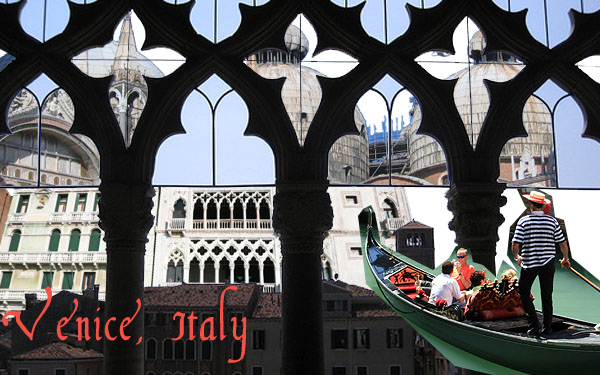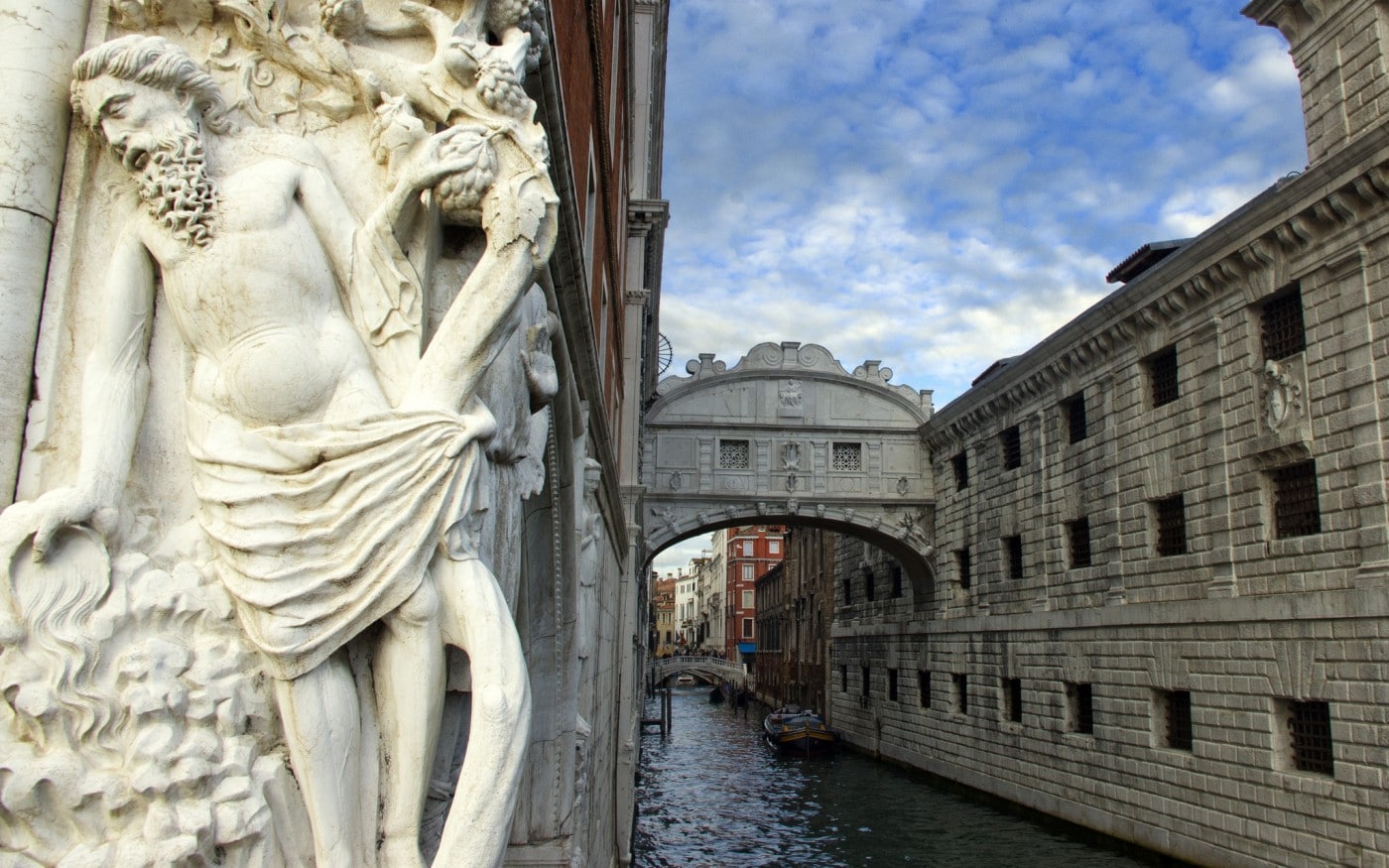
Anything but Italian
On the surface, Venetians fit the Italian profile. They speak the language, eat pasta, dress impeccably and love opera. And yet, they are different. They are less religious, have built no walls around their old city, have sacrificed cars for gondolas, and generally look outward rather than inward for artistic inspiration (the Venice Biennale is a modern-day continuation of this mindset). In some respects, Venice is quintessentially Italian, but in others, it’s a world apart and the Venetians like it that way. This island city has always kept mainland Italy at arm’s length.
Since its’ founding in 697, Venice sought independent status by cultivating strong relations with the East and the blossoming empires of Byzantium and Islam. Given this orientation and their relatively isolated position in the lagoon, Venetians naturally became consummate maritime merchants. By the 13th century, Venice was the principal supplier of the Mediterranean link in the spice trade, controlling nearly 70% of the spices brokered from the Far East into Europe. The spice trade route passed through many great empires of the world including those in China, India, Turkey and Egypt and followed a trajectory to Venetian merchants who were ready to pass the goods on to Western Europe. The traders had particularly close ties to the Eastern Christian Byzantines in what is now Turkey and the Islamic Mamlukes in Egypt. The great cities of Constantinople and Cairo were the showplaces of the world then and their defining monuments– Hagia Sophia and the ornate domes and minarets of myriad mosques – shaped the Venetian aesthetic. After all, you are what you see. These cities had a tremendous impact and Venice sought to emulate elements of each. As a result, the Venetian architectural style is a fusion of both Byzantine and Islamic forms overlaying a Latin Christian foundation. The city’s Eastern influences are often overlooked; you just have to look in the right places to find it.
St Mark’s – the Byzantine influence
Venice’s famed St. Mark’s Cathedral was modeled after the Church of the Holy Apostles, built in the 6th century by Emperor Justinian in Constantinople. This Byzantine church was destroyed by the Turks in 1453, so now the Venetian “copy” is the real thing. In accordance with its’ model, it’s based on a classic, centralized Greek cross design with five domes, one over each arm and one over the central crossing all resting on pendentives, a sort of architectural ice cream cone double scoop where the dome sits atop an arched lower section. Plus, St Mark’s famed mosaics are the quintessential Byzantine decoration. The oldest were executed by Byzantine mosaicists from Ravenna. From an artistic standpoint, these are the most important mosaics in the church and are certainly worth attention. To see them, just look up before you enter the main body of the church, since those most easily visible are located in the narthex, technically the lobby of the church, just above the main entrance doorway. The mosaics are positioned in mini niches, flanked by colonnettes and consist of the Virgin Mary flanked by the apostles and four evangelists. Even in this definitively Byzantine inspired church, there are Islamic influences, for example, the canopies over the domes have a distinct feel of those topping minarets in Mamluke Cairo.
Ca’ D’Oro – the Islamic Influence
This masterpiece of Venetian architecture clearly employs some Islamic elements. The inflected arches of the façade’s windows give the palazzi a distinctive Islamic feel. While the narrow profile of the windows and their arrangement is derived from Christian precedents, their inflected nature has Islamic inspiration. Plus, the shapes above the doorway entrances, although not a perfect match, clearly share the same aesthetic. Also the stone or marble “frame” around the main floor windows – used for the first time in the Gothic period to highlight the importance of these central windows – might have also been an Islamic contribution.
Venice’s predominance as a liaison between East and West gradually diminished at the end of the 15th century, when Portuguese explorer Vasco da Gama rounded Africa’s Cape of Good Hope and landed in India in 1498. For the first time ever, this opened up a direct sea link with the East and Venice’s position in the Mediterranean was no longer critical. This new route focused Europe’s trading orientation westward, the seeds of which had already been planted by Christopher Columbus’ 1492 crossing of the Atlantic to America.
While the Venice of yesteryear is gone, the legacy remains. Keep in mind when touring this city, the voice that echoes is not that of Florence’s Dante Alighieri, that famous Italian pre-Renaissance poet, but rather Venice’s Marco Polo. A walk through Venice is really a walk around the world, a city that truly bridges East and West.
The country code for Italy is 39.
Where to Sleep:
The Dorsoduro district is probably the best part of the city to find a hotel – away from the tourist throngs but still situated centrally, with much of the “must sees” very close-by. The Castello and S. Polo districts are a good second choice.
Centurion Palace Hotel: housed in a former convent with a splendid Venetian-Gothic facade and located at the mouth of the Grand Canal, this 5 star property has a magical ambience that perfectly combines Venetian antiquity with modern Italian flair. Each room and suite is individually decorated in contemporary style and there is a private garden, butler service and gourmet restaurant. Dorsoduro, 173. 41-34281. www.centurionpalacevenezia.com
Hotel Castello: gorgeous paneling, damask fabrics and refined Murano glass give guests the feeling of traveling through time. Comfortable and convenient, this 3 star hotel is less than a minute away from St. Mark’s Square. Campo SS. Filippo e Giacomo; Castello 4365. 41-523-4545. www.hotelcastello.it
Hotel Tivoli: enjoys an excellent position in the historical center of Venice and the staff is extremely friendly. There is a fantastic courtyard for lounging mid-afternoon or evening. Dorsoduro 3838- Crosera San Pantalon. 41-524-2460. www.hoteltivoli.it
Where to Eat:
Antiche Carampane: (the best overall) Great seafood, focused on home-style preparation with high quality ingredients. Excellent, with a solid, friendly staff and classy, casual atmosphere. Antiche Carampane is a great experience, one of our favorites in Italy. Closed Sunday and Monday. San Polo 1911; Rio Terra Rampani; 41-524-0165. www.antichecarampane.com
Alle Testiere: Excellent seafood restaurant but sometimes overly ambitious. Elegant, with good food, cool vibe, and the best wine list. With just 9 tables, reservations are a must. 2 seatings: 7:30 and 9:30. Closed Sunday and Monday. Calle del Mondo Novo, 5801 (Castello); 41-522-7220. www.osterialletestiere.it
Al Covo: Delicious, very high quality Venetian seafood. Right up there with Antiche Carampane and Alle Testiere, however, we would argue that the energy level and feel are superior at the other two. Further, prices here are at least 10-20% higher than the other restaurants. However, this is the best option for dining on a Sunday or Monday, when the other top two are closed (Al Covo is closed Tuesday and Wednesday). Castello, 3968 (Campiello della Pescheria); 41-522-3812. www.ristorantealcovo.com
La Corte Sconta: An old-school seafood-oriented trattoria, that has a slightly simpler décor than the others listed here (tables topped with butcher paper and red napkins); the seafood quality is like Antiche Carampane and Alle Testiere, but it’s more casual and offers simpler preparations. They base their daily menu on whatever the Chioggia fish market has to offer. We do find the service rushed, a bit pushy and prices (food and wine) higher than its peers. Although still a good dining experience, the food is the weakest of the top three. Closed Sunday and Monday; also from 7 January to 7 February, and from 15 July to 15 August. Calle del Prestin, 3886 (Castello) near the Arsenale; 41-522-7024. www.veneziaristoranti.it
Venetian Cicheti e Ombre: Cicheti are the bite-sized “Italian” brethren of tapas (basically, just small sandwiches) and ombre the traditionally tiny glasses that hold a small portion of wine (ombre is translated as “shadow”, apparently where the Venetians drank the wine). Recommended cichetteria:
- Al Marca – Perhaps our favorite in the city. Good for wine, aperitifs (spritz con Aperol or Campari), and mini sandwiches in the evening and coffee in the morning. Stand outside, it’s just a hole in the wall place. Sestiere San Polo, 213/a; Campo Cesare Battisti, near the fish market, just off the Rialto bridge in San Polo; 41-924-781.
- La Cantina – Very good, with good wines and probably the best tasty small plates of meats and seafood. Strada Nuova, Cannaregio 3689; 41-522 8258. Open 10 a.m. to 10 p.m. Closed Sunday.
- I Rusteghi – around the corner from Alle Botte but a little more upscale and less busy allowing for interaction with the family behind the bar. Drinks and small sandwiches. The frizzante rose is worth a try. Campiello del Tentor San Marco, 5513, just off the Rialto bridge (on the other side, however) in the corner of a small campo; 41-523-2205.
- Banco Giro – Good, with a laid-back atmosphere and usually not too busy. You can find this bar after descending from the Rialto bridge behind the markets on the right side. Also serves dinner in the quaint upstairs. Campo San Giacometto, 122, San Polo; 41-523-2061; Open 10:30 a.m. to midnight in summer. Closed Sunday night and all day Monday.
Must See & Do:
St Mark’s Basilica: Be sure to visit from 11:30 AM TO 12:30 PM. The church turns on all of the interior lights for one hour, making for excellent viewing of the mosaics. If you visit at any other time of the day, the natural light is insufficient to allow for proper viewing and the church’s appearance is very dark. Calle de Canonica; 41-522-5205
Ca’ D’Oro: The best view of this magnificent façade is from the opposite bank, just beyond the Rialto Fish market. Calle del Forno, 3854.
Church of San Sebastiano: Incredibly decorated (don’t forget the sacristy – easily missed if you don’t pay attention). This is where Veronese painted nearly every square inch of space in his high-Renaissance, severely foreshortened “di sotto in su” style. Campo dei Frari; 41-275-0642
Scuola Grande of San Rocco: Another incredible site, where the walls are lined entirely with Tintoretto’s highly-charged works, dating from 3 distinct periods: 1564-67 (Sala dell’Albergo), 1570-81 (Upper Hall), and 1582-87 (Ground Floor Hall). Highly recommended! Sestiere San Polo, 3054; 41-523-4864
Santa Maria della Salute: Constructed by Venice’s master architect Baldassare Longhena (1598-1682), the church is a triumph of the late baroque style (it was constructed to invoke Mary to save and protect Venice from the plague); probably one of the only churches in northern Italy to rival the designs of Borromini and Bernini in Rome. Fondamenta della Dogana alla Salute
Tours
- Venicescapes. Great tour operator with comprehensive, off the beaten path tours emphasizing core fundamental themes of Venice’s history. Managed by Michael Broderick, an expat who has lived in Venice for 15 years. The tours are one-on-one, well researched and well-planned. We took the 6 hour tour called “Story of a Mercantile Empire” and 4 hour tour called “Pleasures of Piety”. Telephone: +39 041/520 6361 and www.venicescapes.or
- A cool experience – a tour of a live, reinvigorated gondola building operation. The visits of the Squero start at 10:30 on Tuesdays and Fridays and last about an hour. The tour costs 25 euro per person. The Squero is located near (1 block away from) Fondamente Nove, the northeastern promenade of the city, which is convenient for visiting the island of Murano. Squero Canaletto, in Cannaregio, Building # 6301 www.squero.com

